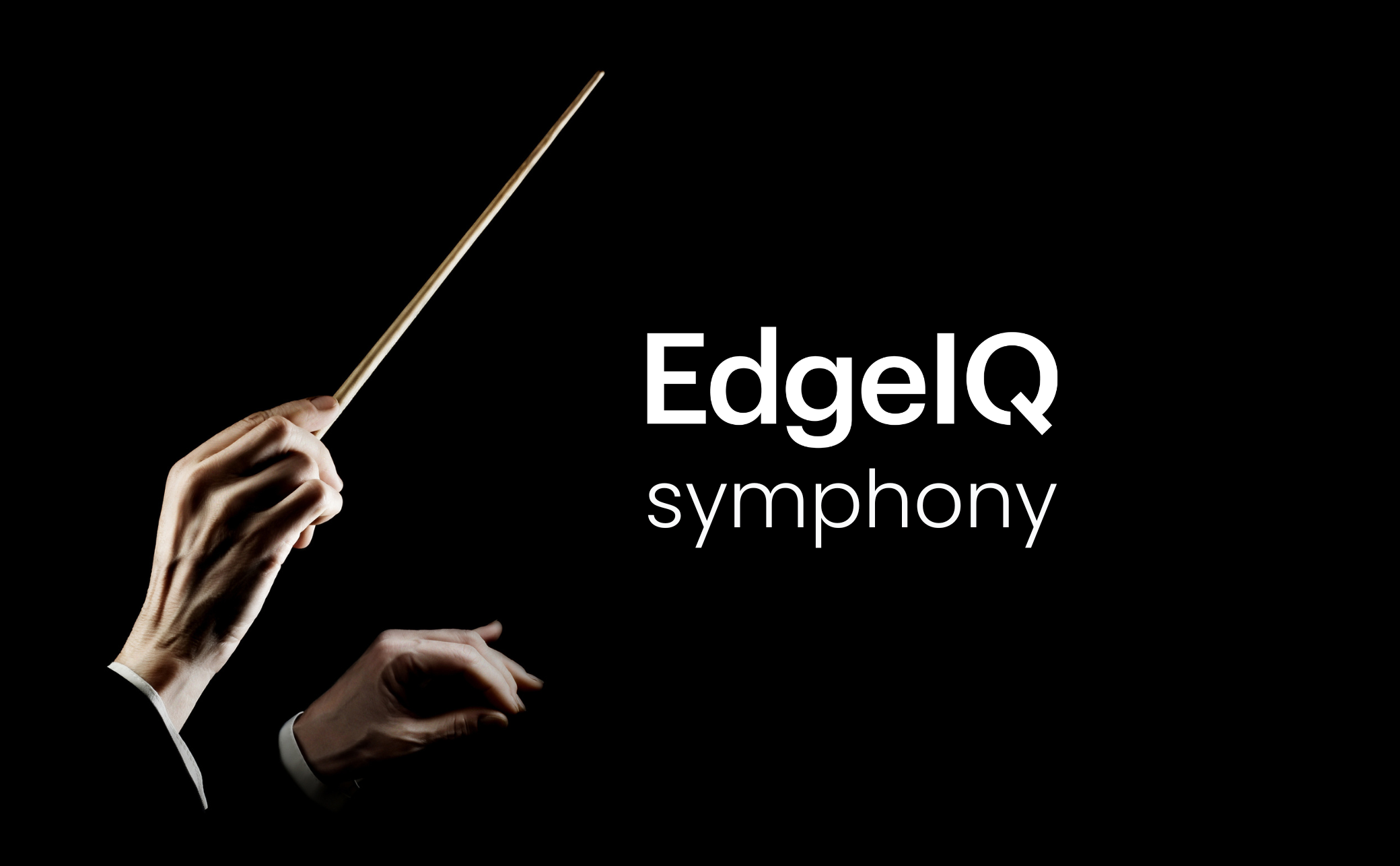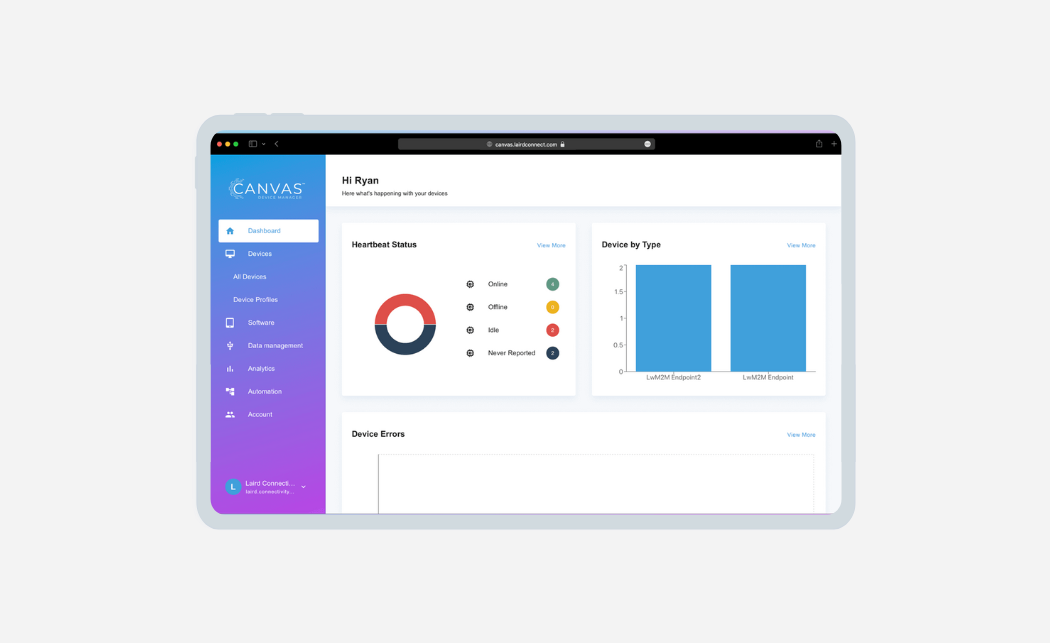Today, we launched EdgeIQ Symphony, an orchestration platform that delivers foundational device, data, observability, and event management workflows for companies that make connected, or IoT, products. Workflows drive outcomes and accelerate business transformation. Point solutions, whether homegrown or third-party, may check feature boxes, but they actually reinforce technology and operational silos. Orchestration-centric platforms are critical in connected product businesses that have complex value chains and technology ecosystems.
EdgeIQ Symphony is a purpose-built platform for connected product businesses that powers three functional applications in the areas of (1) Device and Data Operations, (2) Workflow Orchestration, and (3) Observability. The underlying Symphony platform provides six essential building blocks for these application pillars. These core services include virtual device abstraction, common data and event models, a unified security model, multi-tier user and account hierarchies, and an integration hub. The Operations (Device and Data), Orchestration, and Observability services each draw upon this abstraction layer, providing maximum flexibility and scale.
The EdgeIQ Symphony platform powers three application pillars:
1. Operations
Device Management: Includes a wide range of DeviceOps requirements packaged as workflows, including:
- Fleet Management: Define, organize, and manage device fleets by profiles, accounts, locations, or other criteria.
- Lifecycle Management: See devices in their lifecycle state: unclaimed, active, suspended, maintenance, de-commissioned, and more.
- Provisioning: Define first connection and provisioning workflows, from simple network parameters to complex application orchestration.
- Configuration Management: Manage a wide range of device configurations and application settings, defining templated or custom configurations by device profile.
- Monitoring: Configurable wellness monitoring of hardware, sensors, connections, telemetry data, power, memory, and simple on/off status.
- Diagnostics and Remediation: Leverage wellness data or initiate deep remote terminal access for advanced diagnostics and remediation actions.
- Alerting: Policy-based alerts and notifications driven from any event or workflow and sent via any desired channel.
- Software Updates: Flexible software update management tool for executing software updates and device commands with retry management and audit logs.
Data Management: Data Operations workflows that consume, normalize, and federate device, network, and operational data, including:
- Data Ingest: Protocol-agnostic data ingestion, JSON normalization and filtering for HTTP, MQTT, SMTP, Modbus, OPC-UA, BACnet, and more.
- Data Federation: Set policies to send data from the edge directly to any cloud service, infrastructure, application, or database.
- Data Introspection: Examine data for specific anomalies, thresholds, averages, or other patterns to trigger events and workflows.
- Device Data Storage: Dedicated data storage and retrieval for devices and gateways for immediate and short-term analysis and visualization.
- Telemetry Data Storage: Optional storage of operational telemetry data in addition to the data federation capability.
2. Orchestration: At the heart of a workflow-centric platform are tools to build, manage, and secure highly scalable workflows across the device, data, and user value chain:
- Workflow Composer: No code, drag-and-drop tool for creating, deploying, and automating workflows throughout your application and infrastructure ecosystem.
- Workflow Templates: Leverage reusable workflows and subflows for common processes, including third-party services.
- Composable Subflows: Add and execute subordinate flows to pass variables to broader actions in workflows.
- Conditional Logic Decision Nodes: Execute specific actions, including flow branches, based on one or more conditions being met in a workflow.
- Workflow Governance: Create safeguards to ensure appropriate controls for creating and changing workflows by role and organizations are in place.
3. Observability: The Observability pillar is more than the visualization layer of device status. It provides rich insights into device wellness, data flows, and an audit trail of events and workflows. This expands insights far beyond the device and into the entire business operation.
- Event Logging: This service will log any system event, including device, data, user actions, commands, updates, configuration changes, workflows, and more.
- Workflow Insights: Detailed insights into workflow creation and execution that measure success, failure, latency, and other parameters.
- Aggregated Data Sources: Synthesize any data or event log content to perform aggregated analytics, reporting, and visualization.
- Telemetry Dashboards: Configurable visualization and dashboard on system or operational telemetry data.
- Audit Reports: Leveraging the common event and data models, this service monitors and audits important events, actions, and workflows.
There are four things that make EdgeIQ Symphony both unique and valuable to customers.
- Purpose-built. EdgeIQ Symphony is not just a workflow platform — it is purpose-built for the requirements of connected product companies that must span both the physical and digital domains and a complex technology ecosystem.
- Workflow-centric. EdgeIQ Symphony is not just a collection of device and data management features. It is a collection of workflows built on a platform that lets customers customize their own workflows.
- API-first. Since 2012, EdgeIQ has been and is an API-first platform. We recognize that your business is a vast ecosystem of infrastructure and applications that need to interact with devices, data, and events.
- Brandable Web Application. The brandable web application lets customers receive and provide value on day one. There is no code to write or build. Just create profiles, onboard devices, and go!
Our mission at EdgeIQ is to help businesses win in the Connected Product Economy. Over 40,000 product manufacturers face an existential threat while chasing this once-in-a-generation opportunity. Winners will embrace an outcomes-led mindset and need a workflow-centric framework to achieve their business transformation goals. EdgeIQ Symphony is entirely focused on this purpose and uniquely built to help our customers win.
Device Claiming Workflows - Automating a multi-step process that dynamically assigns a device to a particular customer account and ascribes that account’s unique configuration settings. It involves interaction with the DeviceOps system of record, account/organization information, and often an ERP or CRM system equivalent.
First Connection Workflows - These workflows expand on the simpler zero-touch provisioning process and can include setting network configuration, desired heartbeat frequency and payload, data federation policies, and alert settings. But with smarter edge systems, first connection workflows can now include downloading specific applications, services, and files to devices.
Diagnostics and Remediation Workflows - These workflows transcend simple monitoring and alerting features and allow organizations to define and automate troubleshooting playbooks tailored to different levels of permissions and expertise in a support organization.
Software Update Workflows - Beyond simple firmware updates and commands, these workflows allow highly targeted update processes for specific devices, in particular accounts, in specific locations, and at specified times of the day, with version validation, retry management, and detailed auditing. Software images can be stored in any location designated by the customer.
Service Event Workflows - These workflows replace simpler event-triggered actions or merely integrate with support systems. Service event workflows create tickets with rich data in a designated account, monitor ticket resolution, and report updates back to EdgeIQ in specified metadata fields. These workflows can orchestrate processes among many external systems simultaneously.
EdgeIQ Symphony is an orchestration platform that allows organizations to automate business processes between and among their device, data, and cloud infrastructures, application ecosystems, and the value chain that connects manufacturers with their customers and partners.
With EdgeIQ, customers accelerate and de-risk realizing their business transformation goals because they don't need to build their solution's operational, integration, and automation layers. This means they can focus on what truly makes their offerings differentiated and valuable to customers.
Beyond the value of allocating resources to what’s most strategic, using EdgeIQ also saves organizations hundreds of thousands to millions of dollars in the development and maintenance of undifferentiated infrastructure software.
Customers — Businesses and consumers who buy connected products using EdgeIQ will benefit from the best digital-first offerings in the market.
Product Management and Development Teams — Embracing a workflow-centric mindset and framework ensures the most elegant and extensible solutions in the market. EdgeIQ leads to faster product development by leveraging pre-built workflows, breaking down both technology and operational silos. Leaders will be able to more easily allocate engineers to the most important development assignments and provide challenging work versus the mundane development of software plumbing. The Observability pillar also provides valuable product utilization insights.
Customer Support and Field Service Teams — EdgeIQ Symphony eliminates the swivel chair problem of navigating among multiple systems to understand and acting upon service events and requests. Problems can be identified proactively or in real-time and resolution can be automated with no human intervention. Integrated analytics can even predict issues before they occur.
Executive Management —Senior leaders establish lofty digital and business transformation goals but operate in blind faith that managers know how to execute. EdgeIQ Symphony uniquely supports a framework that ties together the digital and physical domains of connected product companies and a roadmap for achieving transformational outcomes.
Shareholders — Successful connected product businesses achieve a new and rare valuation calculus. Winners will create new, digital-first offerings, reduce costs, increase margins, and increase customer satisfaction and lifetime revenue value. All of this adds up to sustainable market leadership and a new way to value the future business.
EdgeIQ Symphony is available starting July 17, 2024, for existing and new customers. For more information, visit edgeiq.ai or contact us at engage@edgeiq.ai for an immediate consultation.

